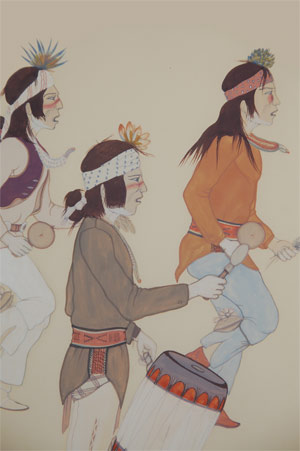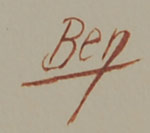Cochiti Pueblo Original Painting of Dancers [SOLD]
+ Add to my watchlist Forward to Friend
- Category: Paintings
- Origin: Cochiti Pueblo, KO-TYIT
- Medium: watercolor on paper
- Size: 13” x 10-1/4” image; 20-1/8” x 17-1/8” framed
- Item # 25620 SOLD
 At the age of 15, Quintana won first prize over 80 contestants, of whom 7 were Indians, for a poster to be used in the Coronado Cuarto Centennial celebration. Later, he won first prize and $1000 in an American Magazine contest in which there were 52,587 entries. As testimony to his interest, he used the prize money to further his art education. At age 21, he was a casualty of World War II.
At the age of 15, Quintana won first prize over 80 contestants, of whom 7 were Indians, for a poster to be used in the Coronado Cuarto Centennial celebration. Later, he won first prize and $1000 in an American Magazine contest in which there were 52,587 entries. As testimony to his interest, he used the prize money to further his art education. At age 21, he was a casualty of World War II.
As a teenage artist, one would expect paintings that were less than perfect; however, Quintana was well above average even at that age. His attention to detail is evident in all of his paintings and his treatment is direct and honest. His use of soft colors provides a pleasing and relaxing image. There is innocence to his paintings that might have been lost as he aged but we will never know.
Clara Lee Tanner, in her book, said of him: "This sensitive artist neglected no small detail in his painting. Colors employed by (him) are soft and pleasing throughout, and his treatment is direct and honest...Cochiti's greatest contributions, in the field of Southwestern Indian art have certainly come through Tonita Peña and her son, J. H. Herrera. Both have done important work in carrying on the traditional pueblo style of presentation....Had Ben Quintana lived, unquestionably, he would have equaled these two."
This painting, when compared to others we have had in the gallery, would appear to be a very early one of his. There is softness to the paint colors that became more intensified in his later works. Although, the span of his early to late works is only about 10 years because of his early death. He had an excellent command of facial features as illustrated by the three faces of these dance participants. He showed a lack of haste in his works and must have been a very patient person who did not rush to complete paintings but labored over each one until he was fully satisfied—a trait not expected of a teenage artist.

Condition: appears to be in excellent condition but has not been examined out of the frame. It appears that the mat board is acid-free indicating that the painting was recently re-framed. A simple silver wood frame was used.
Provenance: from a gentleman in Santa Fe.
Recommended Reading: Southwest Indian Painting: a Changing Art by Clara Lee Tanner
- Category: Paintings
- Origin: Cochiti Pueblo, KO-TYIT
- Medium: watercolor on paper
- Size: 13” x 10-1/4” image; 20-1/8” x 17-1/8” framed
- Item # 25620 SOLD



